#zef culture
Explore tagged Tumblr posts
Text
Hi.
I’m interested in subcultures or counterculture, especially from the 20th century. My main interest revolves around the 1940’s to the 1980’s. I like to learn about the fashion especially, but also music, sports, movies, art, drugs, and sometimes food. I’m terrible at putting things together in a nice, organized manner so it seems like a mess. I’m old, at least for Tumblr, so I can actually remember bits and pieces of the 1980’s. I remember seeing skinheads and wanting to look as cool as I thought they did. I’m talking about the anti-racist skins, of course. I hung out with kids who were into punk rock and skateboarding. I partied with deadheads (started getting high at 14). In the 1990’s I knew a guy who played in a rockabilly band. So, that’s basically where these interests come from, that and I organize dates and historical events in my head and because the after math of World War 2 has affected my life more than anything else it's not that unusual that I'd be interested in post-war subcultures. To a lesser extent I’m also interested in subcultures within lgbtq communities, because I’m queer a.f. Oh, and then there’s that very Tumblr sort of aesthetic from the 2010’s, I love that too. I post stoned.
#me#subcultures#intrest#introduction#Queer a.f.#lgbtq#Aesthetic#skinheads#punk rockers#hippies#greasers#bikers#teddy boys#heavy metal head bangers#heshers#zef#urban cowboys#boot boys#football casuals#rave culture#bd/sm community#leather#deadheads#smoothies#sharpies#suedheads#mods#gutterpunk#crusties#scally
0 notes
Text
2024 Year In Review
2024 was another intense year. It was the first time in twenty years I wasn’t scoring a show for TV, and I got to concentrate on finishing albums and starting new projects. The year began with the premiere of my chamber symphony for Alterity Chamber Orchestra in Orlando and ended with guest-vocalizing with the Losers Lounge Band on a Bowie classic at Joe's Pub in NYC. I completed new albums for Xordox and Venture Bros, to be released in 2025. I released an Archer Soundtrack album and scored a Harry Smith film for L’Etrange Festival in Paris. Worked with Laura Wolf on a new project and premiered my Ensemble project at the Big Ears Festival in Tennessee. Recorded many overdubs for the next Foetus album, also to be released in 2025. Began a new series of sculptural wall pieces. We lost Phill Niblock in January and Steve Albini in May. We lost my colleague Roli Mosimann in September. I still woke up 5am in a panic on too many occasions. As a cultural omnivore, many sights, sounds and stimuli penetrated me.
Albums that I enjoyed in 2024
Sleepytime Gorilla Museum of the Last Human Being (Pelagic) Present This is not the end (Cuneiform) Tristan Perich/Ensemble 0 Open Symmetry (Erased Tapes) Drew McDowall A Thread Silvered and Trembling (Dais) Warrington-Runcorn New Town Development Plan Your Community Hub (Castles In Space) Extra Life The Sacred Vowel (Bandcamp) Geordie Greep The New Sound (Rough Trade) D-en Haut D-en Haut (Pagan) Aksumi Fleeting Future + Lines (Tonal Union) Louis Cole Nothing (Brainfeeder) Uniform American Standard (Sacred Bones) Zeal and Ardor Greif (Redacted) Shellac To All Trains (Touch and Go) Bangladeafy Vulture (Nefarious Industries) Ekko Astral Pink Balloons (Topshelf Records) Kee Avil Spine (Constellation) Fennesz Mosaic (Touch) Marewren Ukouk Round singing Voices of the Ainu 2012-2024 (Pingipung) Elysian Fields What The Thunder Said (Ojet) Melvins Tarantula Heart (Ipecac) Blood Incantation Absolute Elsewhere (Century Media) Aoife O’Donovan All My Friends (Yep Roc) Anna Thorvaldsdottir Aerial (Sono Luminus) Grace Bergere A Little Blood (Casa Gogol) Bob Vylan Humble As The Sun (Ghost Theatre 2) Andy Akiho Kin (Aki Rhythm) Yannis Kyriakides Hypnokaseta (Unsounds) Big | Brave A Chaos of Flowers (Thrill Jockey) The The Ensoulment (Cinéola / earMUSIC) Beth Gibbons Lives Outgrown (Domino) Beak >>>> / Kosmik Musik (Invada) Sebastian Tropic OST (Ed Banger) Chaser Planned Obsolescence (Decoherence Records) Jesus Lizard Rack (Ipecac) Ex East Islander Norther (Rocket Recordings)
Some books I enjoyed
Yuval Noah Harari Nexus Chris Stein Under A Rock Bill Buford Among The Thugs Patricia Highsmith The Talented Mr Ripley Sy Montgomery Soul Of An Octopus Malcolm Gladwell Revenge Of The Tipping Point
Some films I enjoyed
Furiosa ZEF Story Of Die Antwoord Joker Folie A Deux Kneecap Bad Faith Rebel Ridge Hundreds Of Beavers Ministry Of Ungentlemanly Behavior Teachers Lounge
I saw hundreds of concerts in 2024. Some highlights:
01.24.24 The Chisel at Bowery Ballroom 02.15.24 Jack Quartet play Austin Wulliman at Roulette Intermedium NYC. 03.09.24 Louis Cole / Genevieve Artadi at Brooklyn Steel 03.14.24 Kate NV at the Atrium at Lincoln Center 03.18.24 Sleepytime Gorilla Museum at Elsewhere in Brooklyn 03.23.24 Secret Chiefs 3 at Big Ears Festival 03.23.24 Hatis Noit at St John’s Cathedral in Knoxville TN for the Big Ears Festival 03.24.24 Kenny Wollesen’s Sonic Massage at Knoxville Art Museum for the Big Ears Festival 03.24.24 Elliott Sharp’s Void Patrol (with guests Cyro Batista and Colin Stetson) at Big Ears Festival 03.24.24 Aoife O'Donovan with the Knoxville Symphony Chamber Orchestra at the Big Ears Festival 04.01.24 Caleb Landry Jones at The Sultan Room i 04.06.24 Lovely Little Girls at Hart Bar. 04.19.24 Keith Fullerton Whitman performs ‘Playthroughs’ at Ambient Church 04.23.24 Mandy Indiana at Elsewhere in Brooklyn 04.26.24 Knower at the Brooklyn Bowl 05.04.24 Oberlin Contemporary Music Ensemble, directed by Tim Weiss, play Alex Paxton at Long Play Festival 05.04.24 Fuji|||||||||||ta at Long Play Festival 05.05.24 Ligeti Quartet perform Ligeti + Anna Meredith at Long Play Festival 05.17.23 Swans at Music Hall of Williamsburg 05.23.24 The Rolling Stones played at Met Life Stadium in New Jersey. 05.24.24 John Zorn’s ensemble, the New Masada Quartet 06.08.24 Rebekah Heller’s Bassoon Ensemble 06.25.24 Mdou Moctar at Bowery Ballroom NYC 07.12.24 C.Gibbs Review at Barbes 07.23.24 Bangladeafy at The Sultan Room in Brooklyn 08.18.24 Kid Congo and the Pink Monkey Birds at Union Pool 08.23.24 Alarm Will Sound play Marcos Balter’s Code-Switching, 09.30.24 Uniform at Bowery Ballroom 09.04.24 King Dunn aka King Buzzo (Melvins) and Trevor Dunn (Mr Bungle etc) at Music Hall of Williamsburg + White Eagle Hall in Jersey City. 09.13.24 Steven Bernstein and Nels Cline with the Arturo O'Farrill Latin Jazz Orchestra, playing James Bond themes. At Bryant Park in NYC. 09.15.24 PJ Harvey at Terminal 5, NYC 10.11.24 John Zorn’s Cobra in a 40th anniversary performance at Roulette Intermedium in Brooklyn 10.17.25 The The played at the Beacon Theater 10.22.24 Die Antwoord at Brooklyn Steel, 10.23.24 Boris played at Racket in NYC. 11.01.24 William Basinski for Age Of Reflections 11.04.24 Growing performing for Abasement at Artists Space in Manhattan 11.06.24 Pioneer Works presented a concert of Louis Cole Choral Music. 11.08.24 Lankum at Warsaw in Brooklyn 11.17.24 sunn o))) at Lincoln Center for the Unsound Festival 11.21.24 Extra Life at TV Eye. 11.24.24 Zeal and Ardor at Le Poisson Rouge NYC 11.25.24 Axiom, comprised of Juilliard students and conducted by Jeffrey Milarsky playing Solstice Ritual by Augusta Read Thomas 11.26.24 Blood Incantation at Elsewhere 12.01.24 Pharmakon’s awesomely unhinged performance at Union Pool. 12.11.24 Jesus Lizard played a great set at Brooklyn Steel 12.28.24 Grace Bergere / Jon Spencer / Gogol Bordello Capitol Theater Port Chester
Honorable mention to the multiple concerts I attended at the Abasement series at Artist Space, as well as multiple shows by S.E.M. Ensemble and Wet Ink Ensemble
#Extra Life#Zeal and Ardor#playlist#jg thirlwell#Augusta Read Thomas#Blood Incantation#Jesus Lizard#Grace Bergere#Jon Spencer#Gogol Bordello#Abasement#S.E.M. Ensemble#Wet Ink Ensemble#Pharmakon#Sleepytime Gorilla Museum#Ex East Islander#William Basinski#Fuji|||||||||||ta#Louis Cole#knower#uniform#Jack Quartet#Mdou Moctar#Tristan Perich#Warrington-Runcorn New Town Development Plan#chaser#Geordie Greep#Boris#Die Antwoord#The The
47 notes
·
View notes
Note
❤️🩹 🕷️ 🌈for Bodie 
And 🌈❤️🩹🕷️❤️ for zef and Sarahfin 
Bodie:
❤️🩹- So CapitalM actually answered this in a stream once! And the answer is…cry. Boy is so used to being the strong one in whatever relationship he’s in (Platonic or otherwise) that the moment those walls come down all bets are off.
🕷️- Okay I’m not gonna lie, I had intended for these to be truly “irrational” fears as in like…silly stuff. But I really don’t think that Bodie has any fears that aren’t based in a genuinely dangerous/scary experience in his life. So like being alone, having his family taken away, or not being able to keep his family safe are fears rooted in a genuine danger. Not to say that “irrational” fears are invalid or should be mocked, but the term “irrational” means it’s something that either can’t hurt you in real life or isn’t a common enough occurrence to be a danger. The things I mentioned are things Bodie still has to worry about, thus not irrational.
🌈- Bodie cooks a roux based gumbo. As opposed to the objectively wrong tomato based “gumbo” of Creole culture. (I’m totally 100% unbiased and it’s not because I’m Cajun at all.)
Zef:
🕷️- I’m pretty sure this was stated in the first audio of his series, but orcas/dolphins. Again this is kinda something he has to worry about being an ocean creature, but yeah those suckers are vicious.
🌈- I feel like Zef has a sweet tooth. Like obviously under water there aren’t a lot of options for sweet treats (at least that I know of) but the moment he tries human sweets, he’s hooked. Serafin on the other hand doesn’t care for them.
Serahfin:
❤️- He’d probably do it in a way that you wouldn’t realize he’s trying to comfort you unless you really squint. Like at first you think he’s ignoring you but in reality he’s just trying to give you space. He does it because he really doesn’t like to be disturbed when he’s upset, so he assumes everyone else is that way too.
❤️🩹- It depends on what your definition of comforting is. As stated above bro does not like to be around people when he’s sad/agitated. He’ll probably recognize if your affection comes from a genuine place, but he doesn’t like to feel pitied.

#obsidian lantern#gator boys#siren son asmr#asmr roleplay#gator boys belongs to obsidian lantern#zef#serapfin#Zef & Serafin belong to obsidian lantern#capital m audios#answered asks#ask prompt#ask me things#asmr
23 notes
·
View notes
Text
Die Antwoord: La Revolución de la Estética y el Estilo en el Hip Hop Alternativo
Tiempo de lectura: 3 minutos Die Antwoord no es solo una banda, sino un fenómeno visual y cultural. Desde su surgimiento, el dúo sudafricano ha redefinido lo que significa tener una identidad estética dentro del hip hop, llevando el estilo zef a un nivel global. Con una mezcla de arte visual, moda excéntrica y referencias culturales de Sudáfrica, Die Antwoord ha logrado crear un universo visual…
0 notes
Text
Wonder Food Truck-Surprise Your Employees With Pizza On Wheels

In the fast-paced world of corporate culture, expressing gratitude to your staff members is quite important. And what better way to make their day than to show them off with a tasty surprise? In Floral Park, NY, the Wonder Food Truck at ZEF'S PIZZA FIRETRUCK can be an ideal choice to impress your team and make their day extraordinary. Our wonder food truck floral park ny for cheesy and delicious pizza will add a spark and will excite your office members. Curious to know how? Continue reading this blog to know its magic and how it can elevate your team's spirits. Read more: https://zefspizza.com/blog/f/wonder-food-truck-surprise-your-employees-with-pizza-on-wheels
1 note
·
View note
Text
A Milano "Music Week" dal 20 al 26 Novembre 2023

A Milano "Music Week" dal 20 al 26 Novembre 2023 MARTEDÌ 21 NOVEMBRE INCONTRI SPECIALI CON GLI ARTISTI Alle 12.45 al Museo del Novecento Devendra Banhart con Guinevere Alle 19.00 Francesca Michielin con Andrea Delogu al Teatro dei Filodrammatici Alle 20.15 "Ogni fine è un nuovo inizio: intervista a Motta" PANEL "Yas Queen! L’eredità queer di Raffaella Carrà" con Paola Iezzi "The soundtrack of our lives: scrivere colonne sonore per cinema e serie tv” "I producer sono i nuovi compositori?" e “YouTube per i songwriter” presentati da SIAE "Passato, presente e futuro del live in Italia" presentato da ASSOCONCERTI "Musica dal vivo: come potenziare l'export del Made in Italy?" presentato da ASSOMUSICA "Il calcolo dei diritti connessi: criteri e modelli a confronto" presentato da NUOVO IMAIE "All About Vevo: a tu per tu con il più grande network di video musicali al mondo" presentato da VEVO "Guida pratica al mercato musicale asiatico" presentato da Italia Music Export Al Meet Digital Culture Center il più importante convegno europeo sul diritto d’autore musicale. Music Minds Europe 2023 Programma completo su questo link e quest'altro link Tanti gli eventi in programma domani, martedì 21 novembre, per la Milano Music Week, promossa e fortemente voluta da Comune di Milano - Assessorato alla Cultura, ASSOCONCERTI, ASSOMUSICA, FIMI - Federazione Industria Musicale Italiana, NUOVO IMAIE e SIAE - Società Italiana degli Autori ed Editori, con il patrocinio del Ministero della Cultura, sotto la direzione artistica di Nur Al Habash (direttrice della Fondazione Italia Music Lab) e con la curatela speciale di Francesca Michielin. Main sponsor di questa edizione UniCredit, UniCredit Allianz Vita e UniCredit Allianz Assicurazioni. Alle ore 12.45 Milano Music Week ha organizzato un incontro speciale al Museo del Novecento con DEVENDRA BANHART (la sera stessa in concerto all’Auditorium), dal titolo "But the Grass is Always Green: Devendra Banhart in conversation with Guinevere". Il talk sarà in lingua inglese. FRANCESCA MICHIELIN porterà per la prima volta il suo Maschiacci a teatro con ospite Andrea Delogu. Alle ore 19.00 al Teatro dei Filodrammatici. Casa Milano Music Week in Torneria Tortona (via Tortona, 32) sarà aperta dalle ore 11.00. Il primo panel è alle ore 12.15 con "Il calcolo dei diritti connessi: criteri e modelli a confronto" presentato da NUOVO IMAIE con Mariano Fiorito, Alessandro Marconi, Maila Sansaini, modera Cristiana Tomei. Il pomeriggio comincia con due panel presentati da SIAE che mettono al centro rispettivamente due figure che sempre più hanno un ruolo fondamentale nell’industria musicale: alle ore 14.15 uno sguardo sul misterioso lavoro di compositore di colonne sonore con "The soundtrack of our lives: scrivere colonne sonore per cinema e serie tv” con Pivio, Yakamoto Kotzuga, Elisabetta Biganzoli, Ginevra Nervi e alle ore 15.15 un focus su come i producer stanno cambiando l’editoria "I producer sono i nuovi compositori?" con Zef e Nicola Migliardi, modera Claudio Cabona; alle ore 16.15 "Musica dal vivo: come potenziare l'export del Made in Italy?" presentato da ASSOMUSICA con Carlo Parodi, Rita Zappador,Maurizio Forte, Sen. Simona Malpezzi, On. Federico Mollicone, modera Luca de Gennaro; alle ore 16.15 "All About Vevo: a tu per tu con il più grande network di video musicali al mondo" presentato da VEVO con Chiara Bonarrigo; alle ore 17.15 "YouTube per i songwriter” presentato da SIAE con Chiara Santoro, Jenna Rubenstein e Omar Ambrosi, introduce Matteo Fedeli, conclusioni affidate a Lyor Cohen; alle ore 17.15 "Guida pratica al mercato musicale asiatico" presentato da Italia Music Export, con Alessandro Pavanello, Francesco De Santi, Gionata Caracciolo, modera Marianna Baroli; alle ore 18.15 "Passato, presente e futuro del live in Italia" presentato da ASSOCONCERTI con alcuni dei principali organizzatori di concerti del nostro Paese per fare il punto sulla situazione attuale e discutere di ciò che sarà: Francesco Cattini, Roberto De Luca, Maurizio Salvadori, Ferdinando Salzano, modera Giampiero Di Carlo. Casa Milano Music Week ospiterà anche due incontri con gli artisti. Alle ore 19.15 "Yas Queen! L’eredità queer di Raffaella Carrà" con PAOLA IEZZI, Fabio Canino e Luca De Gennaro che raccontano la vera icona della musica italiana e alle 20.15 "Ogni fine è un nuovo inizio: intervista a MOTTA" moderata da Michele Bisceglia. RTL 102.5, radio ufficiale della MMW, segue gli eventi con collegamenti in diretta da Torneria Tortona e copertura social. È in distribuzione la guida cartacea della settimana realizzata dal media partner Mi-Tomorrow, con approfondimenti e interviste. Molte realtà hanno organizzato eventi speciali intorno alla Milano Music Week in tutta la città. Al Meet Digital Culture Center alle 11.00 si tiene la conferenza Music Minds Europe 2023, il più importante convegno sul diritto d’autore musicale (che lo scorso anno si è svolto a Parigi), organizzato da ICMP International Confederation of Music Publishers, l’organismo globale per l’industria dell’editoria musicale, e coordinato da FEM. Italia Music Export ha organizzato un songwriting camp internazionale per musiciste e producer in collaborazione con She Is The Music e altri cinque music export office. L’evento coinvolgerà 14 artiste e producer da tutta Europa per una settimana in studio di sessioni di co-scrittura e una listening session finale. Rockol, tra i media partner della Milano Music Week, in qualità di produttore di contenuti organizza una serie di eventi che avranno luogo in diverse venue della città, tra martedì 21 e sabato 25 novembre. Si comincia domani all’Arci Bellezza con il Tunecore Day, evento organizzato da TuneCore Italy con la collaborazione di Rockol. Al SAE Institute di Milano in collaborazione con Ableton, e in coda all’evento di presentazione del nuovo Ableton PUSH, un talk con Elasi e Plastica, produttrici, DJ, autrici e fondatrici di POCHE, collettivo di produttrici italiane. Da martedì a sabato Hard Rock Cafe Milan e SAE Institute presentano “Music Brunch”, una rassegna con ospiti e esperti del settore dell’audiovisivo e dell’industria culturale moderata da Damir Ivic dedicata a cinque temi legati al music business: installazioni audiovisive, intelligenza artificiale, questione di genere, innovazione tecnologica dei podcast e comunicazione musicale. Mare culturale urbano propone per la Milano Music Week il meglio delle rassegne musicali che lo animano abitualmente con cadenza settimanale, a cominciare da domani con il Jazz a Mare e il concerto dei Tendha a cura di Novara Jazz. Sui tavolini del Bar Mosso, Metratron organizza un incontro speciale, aperto a tutti i fan, con Olly e Jody Cecchetto. Alla Sound Faktory di Joe T Vannelli l’incontro fra gli Autori di Saifam e il reparto A&R per intavolare una discussione sui pregi e difetti dello stato attuale del songwriting e del pitching. CPM Music Institute organizza una serie di Masterclass, le modalità di prenotazione e di accesso agli appuntamenti sono disponibili sul sito della scuola di Musica. Spazio anche ai libri con Massimo Cotto alle 18.00 alla Feltrinelli in Duomo che presenta “Il rock di padre in figli*” per Gallucci Editore, e alle 19.30 al Mercato Centrale Milano Livia Satriano creatrice di Libri belli che scorre una carrellata di titoli (e copertine) a tema “musicale”, dagli anni ’40 a oggi, in conversazione con Giulia Cavaliere. Tantissimi gli eventi serali. Sony Music Italia lancia il progetto Afroteque con un party al Moysa. Tra i concerti: Oliver Tree al Fabrique, Devendra Banhart all’Auditorium, Fasma ai Magazzini Generali, Elodie al Mediolanum Forum di Assago. Per la prima volta, il compositore Francesco Messina esegue dal vivo insieme a Michele Fedrigotti (pianista) e Marco Guarnerio (musicista e sound engineer) l’album di culto “Prati Bagnati del Monte Analogo”, all’Auditorium San Fedele, anticipato da Marta Salogni. L’evento apre la nona edizione di Linecheck Music Meeting and Festival, Main Content Partner della MMW. Tutto il programma è consultabile al seguente link Per ogni evento sono indicate le modalità di prenotazione o di acquisto della prevendita. Patrocinatore Istituzionale: Ministero della Cultura. Linecheck Music Meeting and Festival è Main Content Partner della MMW. Partner: A.F.I. Associazione Fonografici Italiani, EMUSA, Evolution, FEM Federazione Editori Musicali, PMI - Produttori Musicali Indipendenti e SCF. Main sponsor: UniCredit, UniCredit Allianz Vita e UniCredit Allianz Assicurazioni. Educational partner: Master in Comunicazione Musicale/ALMED (Università Cattolica), SAE Institute, Scuola Mohole, Scuola APM e Alma Mater Studiorum - Università di Bologna. Sponsor: TicketOne, Amazon Music, M.A.S.T powered by Believe, Spotify, Vevo, YouTube. Radio ufficiale RTL 102.5. Media partner: Rockol, Rolling Stone Italia, Rockit, Cosmopolitan, belive, Mi-Tomorrow, Cromosomi, Billboard Italia. Si ringraziano i technical partners Torneria Tortona, Archiproducts e Santeria. Si ringrazia l’hospitality partner 21 House of Stories Hotel. L’immagine della Milano Music Week 2023 è curata da Pop-Eye Studio. Con il supporto di YES MILAN... #notizie #news #breakingnews #cronaca #politica #eventi #sport #moda Read the full article
0 notes
Text
Ninja is my daddy
5 notes
·
View notes
Text

Working on some research and development for a new project
#art student#artist#artists on tumblr#art blog#artwork#aspiring artist#art#art portfolio#concept art#my art blog#marker art#character aesthetics#aesthetic#chappie#zef#zef style#zef culture#die antwoord
4 notes
·
View notes
Text
Just so you know, "Zeus" (Ζεύς), "Orpheus" (Ορφεύς) or even "Zagreus" (Ζαγρεύς) are pronounced "Zefs", "Orphefs" and "Zagrefs" in Greek, the diphtong "εύ" making the sound "ef" (like "left")
Whatever weird substitutes in English or French or whatever they invented instead by seing the letters without any elementary notions of Greek and being like "oh ok let’s pronounce it with the rules of my native language" make me cringe so much
#greek#gods#zeus#orpheus#zagreus#greek gods#culturalization#cultural appropriation#ignorance#urgh white people white peopling#please pronounce it right for zefs’ sake
5 notes
·
View notes
Text
Russian Fairy Tales Unit 3 Review: Avant-Garde & Socialist Realism
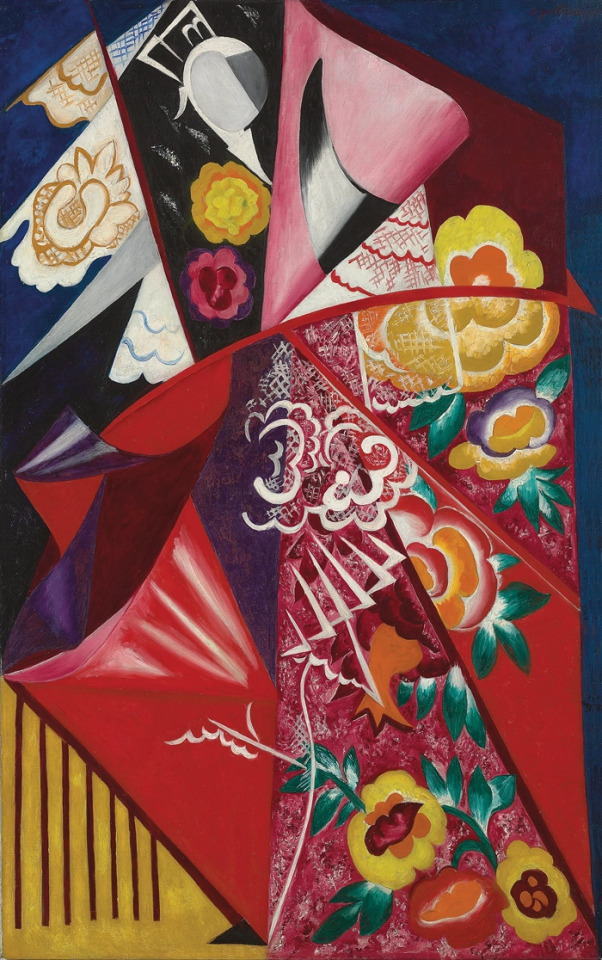
Attributes of Soviet Modernist Culture:
- proletarian - didactic - rational - urban - modern - militaristic/adventurous - utopian
The Avant-Garde:
- the vanguard of art - embraced new artistic techniques and new ideas about what constituted art
Socialist Realism
1932: term first used at Soviet Writer’s Union
1934: concept adopted at First Writer’s Union Congress
- the only state-sanctioned method for producing Soviet art and literature
- a method to produce art that is a “truthfully historically concrete representation of reality in its historical development”
Socialist Realism is...
proletarian (accessible, easily understandable, relevant to peasants and workers)
typical (scenes of everyday life and ordinary people)
realistic (not abstract or non-representational)
partisan (supportive of the Party and the State)
According to Socialist Realism, art should be...
- monumental
- unambiguous
- teaching Party-sanctioned lessons
- teleological; everything leads to a bright future
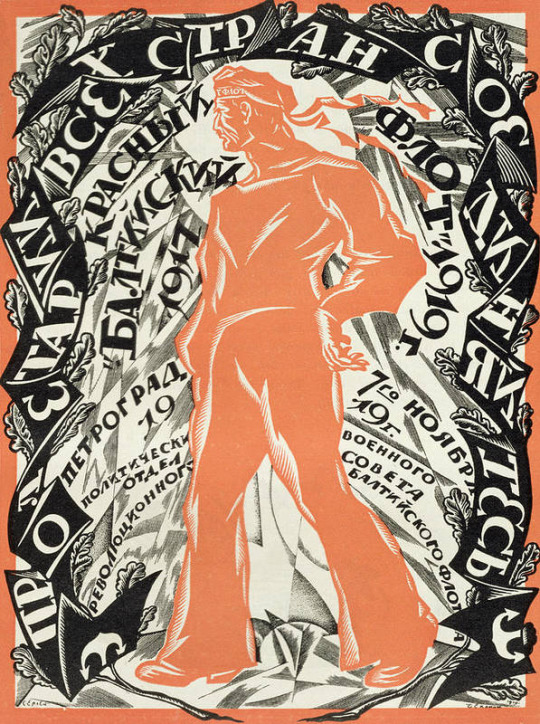
Sergei Vasil’evich Chekhonin, Petrograd Red 7th November (1919)

Aleksandr Deineka, Textile Workers (1927)
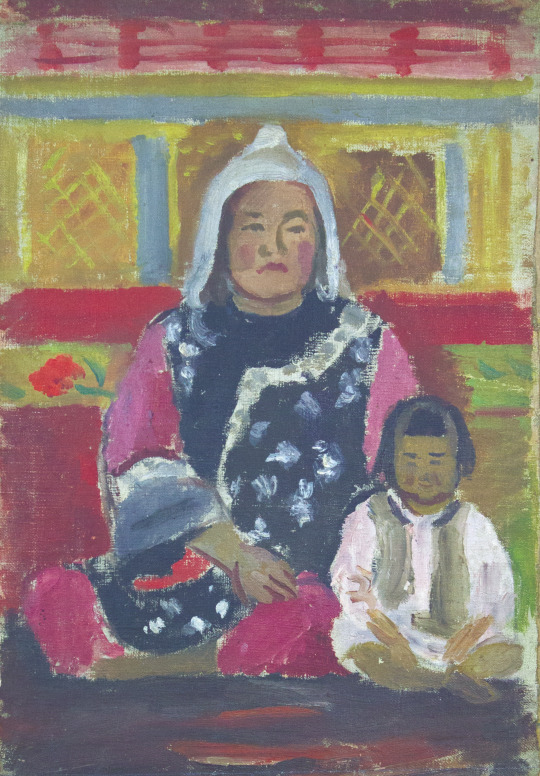
Semen Chuikov, Dungan woman (1929)
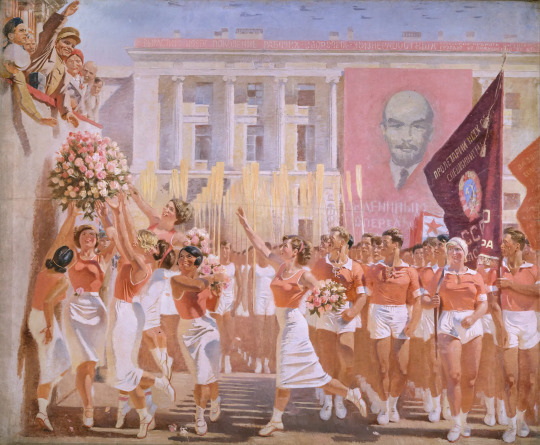
Alexander Samokhvalov, Sergei Kirov Reviews the Athletic Parade (1935)

Yuri Pimenov, New Moscow (1937)

Alexander Gerasimov, Stalin and Voroshilov at the Kremlin (1938)

Wojciech Fangor, Forging the Scythes (1954)

Lu Yanshao, An Emerging Industrial City (1962)

Viktor Ivanov, Family (1964/1965)

Satar Aitiev, For World Peace! (c. 1970)

Zef Shoshi, Going to Work (1970)

Tang Daxi, The People’s Apples (1973)

Song Wenzhi, Taihu’s New Look (1979)

Koço Vogli, I Am a Soldier (1983)

Mels Akynbekov, Shepherds (1984)

Robert Permeti, We Must Win (1984)
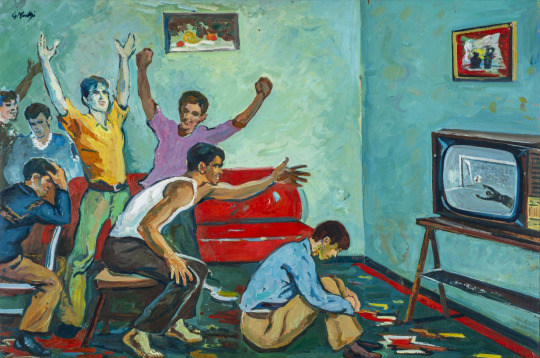
Guri Madhi, When We Don’t Go to the Stadium (1986)

Park Ryong, Farewell (1997)

[caption translates to “We were born to make fairy tales come true!”]
Katerina Clark & The Soviet Novel (1981)
Clark’s book changed the way Socialist Realism was studied. Socialist Realism combines realistic and utopian elements, “the most matter-of-fact, everyday reality and the most heroic prospects.” Of course, this makes Socialist Realist narratives like fairy tales.
Clark’s Master Plot
Positive Hero (moves from spontaneity to consciousness)
Task
Mentor
Trials (task is frustrated)
Climax (appears that task will fail)
Consultation with the Mentor
Hero Receives Object from Mentor
Completion of the Task
Happy Ending
#socialist realism#avant-garde#soviet modernism#russian literature#russian art#soviet art#art history#study blog#russian fairy tales
51 notes
·
View notes
Text
Why Ur Fav is Problematic: Die Antwoord
If You have Tik Tok and you come across a song that is sung by a group called Die Antwoord. Please don’t support them and fact they still have music playing on the app is absurd to me. Here’s the most criminal-based things they’ve done and they should be investigated for:
1. Sex Trafficking
An Australian Rapper named Zheani decided to make a diss track called ‘Question’ dedicated to Die Antwoord mostly to one of the members, Ninja. In the diss track, she said that Ninja trafficked her and was sick individual that compare her to his daughter. She also brought up sexual abuse, fan grooming as well as ritualistic and revenge pornography. Zheani made a music video where she exposed him with multiple screenshots of social media posts, news articles and explicit texts between Ninja and herself back in 2013.
2. Homophobia/false accusations
In 2012 during the Australian Festival Music, a video of both die antwood members, Ninja and Yolandi Visser chasing Andy Butler of Hercules and Love Affair while saying homophobic slurs against him. They accused Butler of sexual assault and it wasn’t “hate crime” but a video was released of Ninja coaching the group to tell people that Butler sexually assaulted a girl but said it was Yolandi who was sexually assaulted. They fabricated the story.
3. Racism
Die Antwoord uploaded a music video called ‘Fatty Boom Boom’ where they used blackface. The group see themselves as leaders of Zef Counter-Culture, a supposedly Afrikaans working-class movement. The truth is the guy name Ninja is neither a working-class nor Afrikaans-speaking. In fact, his previous projects were all rap in English language. His real name is Watkin Tudor Jones. He decided to adopt the Afrikaans working class persona, Ninja in order to get more noticed. There have been a lot of singers like Die Antwoord who adopt a certain black culture to get more recognition and famous. They created a coloured version of themselves because people love black music, they don’t like when it’s sung by a black person. While Ninja is borrowing heavily from male, “coloured” Afrikaans-speaking working-class stereotypes from the Cape. Most Cape Afrikaans and Xhosa rappers aren’t getting same recognition as die Antwod as they should. This is cultural appropriation. Here’s an article that goes into more detail about the music video:
A video was released by Ben Crossman who used to work with the duo. He also released a homophobic incident and them fabricating the sexual assault. In the video, Ninja and Yolandi are saying racial slurs like the n word multiple times. There’s a clip of Yolandi calling the late Singer, Whitney Houston a “crack whore bitch” on the night of her death and even called someone from the audience a “swart naal” which means “black f**k” while onstage.
So these are things I found that shows Die Antwoord is racist, homophobic who lies about sexual assault but has been exposed of sex trafficking. The fact that they are still around because people use their songs on Tik Tok is disgusting.
8 notes
·
View notes
Text
Die Antwoord Controversy
I would like to talk about the South-African band call Die Antwoord today. It was one of my favorite band until I discovered that they were very controversial and I have to admit that I was very disappointed. It is also important, I think, to say when an artist makes something that isn’t right or that doesn’t correspond to your values and it is here the case.
Quick introduction about them but perhaps you know them through the movie « Chappie » released in 2015. The band is composed by Yo-Landi Vi$$er, Ninja and DJ Hi-Tek. Their music is described as rave and hip-hop alternative but also part of the south-African counter-culture movement « Zef », which means, I quote Die Antword « It's associated with people who soup their cars up and rock gold and shit. Zef is, you're poor but you're fancy. You're poor but you're sexy, you've got style. ».
Now, let’s talk about the controversy.
First problem about hem is that they make cultural appropriation, in fact, according to an article in The Guardian ( https://www.theguardian.com/global/2012/oct/22/die-antwoord-blackface-south-africa ), they adopted the «"coloured", Afrikaans-speaking working-class stereotypes from the Cape », but neither Yo-Landi, nor Ninja is one of it. Furthermore, they use afrikaans dialect, beats and codes in their songs.
As I had mentioned in my past blogpost, when I listen to music I don’t always pay attention to the lyrics or to their meanings and I also don’t really often watch the music video. But I learned that it’s really important to understand the artists’ point of view etc.
The band is south-African, but as many of South-Africa inhabitants, they are: white. Even if they grew up with black culture their skin stays white! And when I realized that in their music video « Fatty Boom Boom », which is a parody of western representation of America, that Yo-Landi made a blackface, I thought that there was a huge problem. (You can watch it on Youtube as I mentionned, because I am not linking it) The music video came out on Youtube in October 2012 and is still online! I looked closer to the producers and who came out with this “idea”, and it was none than Ninja himself. He directed it, designed the costumes and made the make-up and body paint. This blackface directly make us think about racist theatre and musicals in the US but also makes allusion the Coon Carnival in South Africa where white people used to blackface… Big throwback to the 19th century!
They are other example of their cultural appropriation and racists acts in their songs but it would be sadly to long to explain each of them. This made me realize how important it is to make research about the artists we listen to. I went to two concert of Die Antwoord, they were amazing, but I regret supporting them for the reason mentioned above… They also did great things like enhancing beauty diversity, especially in the video clip « I think you Freaky » but this can’t excuse what they did.
I find it incredible that in the 21th century people are still making such things! They are spreading, through their music, a wrong message and a bad image. They have so many supporters, listeners but I am sure that most of them are unaware. They never apologize, never talked about it. Also, they are mostly signing in english but some part are in afrikaans so we can hardly understand a word of it…
What do you think?
7 notes
·
View notes
Text
Killer robots already exist, and they’ve been here a very long time
by Mike Ryder

Mykola Holyutyak/Shutterstock
Humans will always make the final decision on whether armed robots can shoot, according to a statement by the US Department of Defense. Their clarification comes amid fears about a new advanced targeting system, known as ATLAS, that will use artificial intelligence in combat vehicles to target and execute threats. While the public may feel uneasy about so-called “killer robots”, the concept is nothing new – machine-gun wielding “SWORDS” robots were deployed in Iraq as early as 2007.
Our relationship with military robots goes back even further than that. This is because when people say “robot”, they can mean any technology with some form of “autonomous” element that allows it to perform a task without the need for direct human intervention.
These technologies have existed for a very long time. During World War II, the proximity fuse was developed to explode artillery shells at a predetermined distance from their target. This made the shells far more effective than they would otherwise have been by augmenting human decision making and, in some cases, taking the human out of the loop completely.
So the question is not so much whether we should use autonomous weapon systems in battle – we already use them, and they take many forms. Rather, we should focus on how we use them, why we use them, and what form – if any – human intervention should take.

Autonomous targeting systems originated with innovations in anti-aircraft weaponry during World War II. Zef Art/Shutterstock
The birth of cybernetics
My research explores the philosophy of human-machine relations, with a particular focus on military ethics, and the way we distinguish between humans and machines. During World War II, mathematician Norbert Wiener laid the groundwork of cybernetics – the study of the interface between humans, animals and machines – in his work on the control of anti-aircraft fire. By studying the deviations between an aircraft’s predicted motion, and its actual motion, Wiener and his colleague Julian Bigelow came up with the concept of the “feedback loop”, where deviations could be fed back into the system in order to correct further predictions.
Wiener’s theory therefore went far beyond mere augmentation, for cybernetic technology could be used to pre-empt human decisions – removing the fallible human from the loop, in order to make better, quicker decisions and make weapons systems more effective.
In the years since World War II, the computer has emerged to sit alongside cybernetic theory to form a central pillar of military thinking, from the laser-guided “smart bombs” of the Vietnam era to cruise missiles and Reaper drones.
It’s no longer enough to merely augment the human warrior as it was in the early days. The next phase is to remove the human completely – “maximising” military outcomes while minimising the political cost associated with the loss of allied lives. This has led to the widespread use of military drones by the US and its allies. While these missions are highly controversial, in political terms they have proved to be preferable by far to the public outcry caused by military deaths.

A modern military drone. Alex LMX/Shutterstock
The human machine
One of the most contentious issues relating to drone warfare is the role of the drone pilot or “operator”. Like all personnel, these operators are bound by their employers to “do a good job”. However, the terms of success are far from clear. As philosopher and cultural critic Laurie Calhoun observes:
The business of UCAV [drone] operators is to kill.
In this way, their task is not so much to make a human decision, but rather to do the job that they are employed to do. If the computer tells them to kill, is there really any reason why they shouldn’t?
A similar argument can be made with respect to the modern soldier. From GPS navigation to video uplinks, soldiers carry numerous devices that tie them into a vast network that monitors and controls them at every turn.
This leads to an ethical conundrum. If the purpose of the soldier is to follow orders to the letter – with cameras used to ensure compliance – then why do we bother with human soldiers at all? After all, machines are far more efficient than human beings and don’t suffer from fatigue and stress in the same way as a human does. If soldiers are expected to behave in a programmatic, robotic fashion anyway, then what’s the point in shedding unnecessary allied blood?
The answer, here, is that the human serves as an alibi or form of “ethical cover” for what is in reality, an almost wholly mechanical, robotic act. Just as the drone operator’s job is to oversee the computer-controlled drone, so the human’s role in the Department of Defense’s new ATLAS system is merely to act as ethical cover in case things go wrong.
While Predator and Reaper drones may stand at the forefront of the public imagination about military autonomy and “killer robots”, these innovations are in themselves nothing new. They are merely the latest in a long line of developments that go back many decades.
While it may comfort some readers to imagine that machine autonomy will always be subordinate to human decision making, this really does miss the point. Autonomous systems have long been embedded in the military and we should prepare ourselves for the consequences.

About The Author:
Mike Ryder is an Associate Lecturer in Philosophy at Lancaster University
This article is republished from our content partners at The Conversation under a Creative Commons license.
33 notes
·
View notes
Text
Maximus referencing anime and the Ramayana in the same breath. Maximus listening to Gangnam Style and watching Cambodia shadow plays. Maximus knowing about white South African "zef" counter-culture and the Maasai people's religious system of laibon. Maximus knowing more about the Himalayan tribes who lived nearby Old Attilan than most anthropologists do, because that's where his interest in humans started. Maximus’s interest in/references to “human culture” going beyond just Shakespeare, Churchill, the Bible, and North American pop culture because, as @allwillbeone has pointed out, that really doesn’t make much sense for him to limit himself to (especially for a guy whose home was in the Himalayas growing up) and is probably just due to white American writers thinking this stuff is universal.
20 notes
·
View notes
Text
This is a v off brand post but it’s hilarious to me that, as a South African, Die Antwoord (or dye ant word as y’all pronounce it 🙄) is seen as this edgy cool like idk rap group when here they are literally just seen as gross and trashy. Kudos to them for harnessing niche South African Zef culture and making it cool to an international audience.
5 notes
·
View notes
